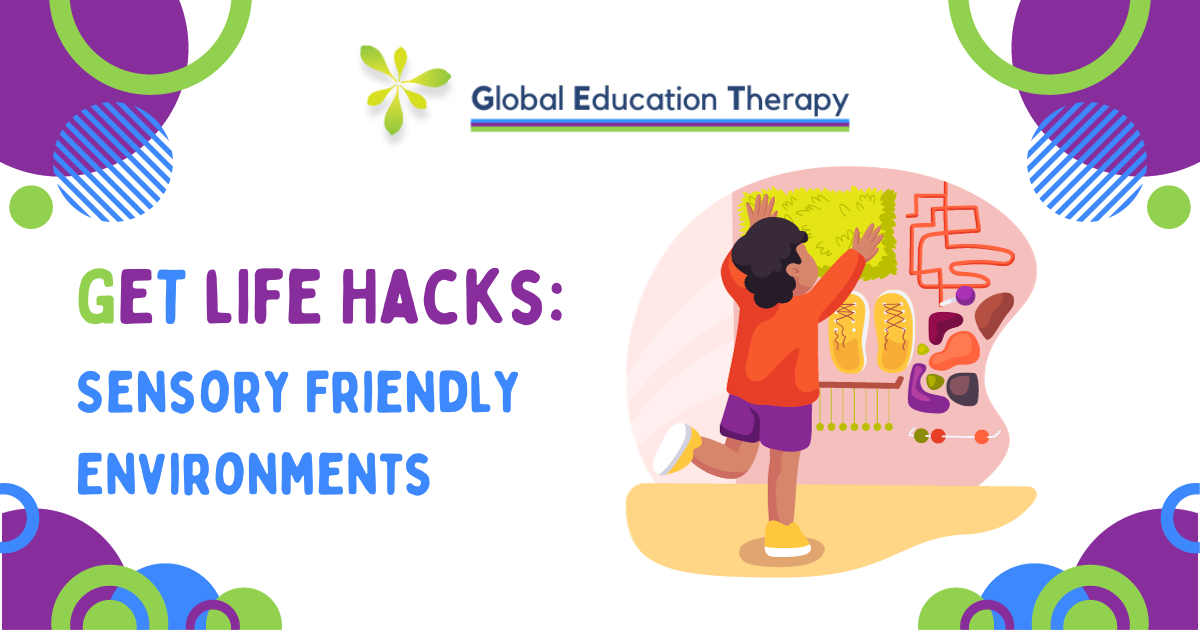GET Life Hacks: Sensory-Friendly Environment
Autism and Sensory Integration
When you have autism, sensory input typically lands in one of two extremes. On one end of the spectrum, sensory input is extremely overwhelming. On the other end, sensory input is hardly felt. Those who barely feel sensory input are called “sensory seeking.” These individuals crave additional sensory input because their’s are diminished. Those who have sensory overwhelm fall into the category of “sensory sensitivity” or sensory avoidance. [1] Sensory sensitivity may look like extreme sensitivity to light, sounds, touch, smells, and other sensory stimuli.
How does this affect home life?
Home is supposed to be a safe place where you spend time with the ones you love. But what happens when a home is overwhelming? Below are some life hacks to help create a safe, sensory-friendly home!
Adjust Visual Stimuli
Choose lighting that is as close to natural light as possible. Fluorescent lights may be too bright, or too loud, and they may flicker. Dimmable LED lighting is preferred.
Try to avoid bright colors when painting or decorating. Go for muted or neutral colors. Get decorations simple and monochromatic
Get organized. Organization helps make routines easier. This means putting items in places where they belong (e.g., shelves, bookcases, and bin systems)
Remove barriers that break up the line of sight allowing an individual to preview the space before entering it.
Less furniture is more. You can incorporate an in-home walking loop for pacing behaviors.
For more information about visual stimuli in your home and how it affect an autistic loved one, visit [1]:TheraSpecs: Light Sensitivity in AutismAspergers 101: Aspergers and Sensitivity to Color – Interior Designer Focuses on Interiors for Those with AutismInside the Autism Experience: Autism and Visual Clutter
Pay Attention to the Sounds in Your Home
Replace hard floors with noise-dampening carpeting or carpet pads that dampen sounds. [1]
Thick insulated windows are good at blocking noise. So is sound-absorbing insulation.
High-quality audio is better. Low-quality audio has high-frequency sounds like white noise that can trigger sensory overwhelm. [1]
For more information about the sense of hearing and individuals with autism, and what you can do at home, visit [1]:Autism Speaks: Autism and Auditory Processing Disorder: What’s the Connection?Synapse: When The World Won’t Shut UpFriendship Circle: Noise Control – 11 Tips for Helping Your Child with Autism Deal with Noise
Reduce the Number of Smells in Your Home
Avoid Candles, fragrances, air fresheners, and cleaners with fragrance.
Proper ventilation can also help reduce home odors.
HEPA filters for your HVAC system can also help with odors.
For more information about reducing odors in the home and the way the sense of smell affects individuals with autism, visit these resources [1]:Aspergers 101: Sensory Processing Difficulties – Smell with ASDNational Institutes of Health: Volatile Organic CompoundsCar Autism Roadmap: Sensory Difference in ASD – Smell
Make the Home Tactile Friendly
Incorporate different textures in the home
Add non-slip surfaces to the bathroom floor/tub,
Create a water play area
Add safety features to the bathroom like grab bars.
Make sure things within their reach are safe to touch.
For more information about tactile changes to make for loved ones with autism or sensory processing issues, visit these resources [1]:Sensory Processing Disorder: Environmental Modifications to Help Children with sensory Processing/Sensory Integration DisordersUnderstood.org: Sensory Processing Issues – Strategies You Can Try at HomeUCSF: The Unbearable Sensation of Being – Living with Sensory Processing Disorder
Build a Sensory Room
An OT can assist you in finding appropriate materials to add to your sensory room. Some basic ideas include a swing, sensory bins with items hidden in rice, and play equipment for gross motor movements such as slides, trampolines, climbing walls, or ball pits. Need an OT? Schedule a free consultation with our online occupational therapist!
Purchase furniture that allows for deep pressure like bean bags.
Make sure to incorporate calm, soothing lighting options. While adding all of these items to your sensory room, make sure it is still organizing. [1]
Consider creating a cool-down room
A cool-down room provides a safe place for a child to have a meltdown.
Some suggestions for a cool-down room include strengthening windows, adding soft mats, only allowing objects with softened edges, controlling the lighting with a dimmer, hanging drapes not blinds, and using velcro instead of curtain rods. [1]
It’s up to you to ensure your home environment is a safe one. Hopefully, these resources can help you create a home where you, your child, or a loved one feel at peace.



